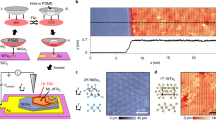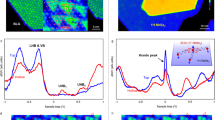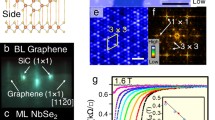Abstract
A quantum spin Hall (QSH) insulator is a novel two-dimensional quantum state of matter that features quantized Hall conductance in the absence of a magnetic field, resulting from topologically protected dissipationless edge states that bridge the energy gap opened by band inversion and strong spin–orbit coupling1,2. By investigating the electronic structure of epitaxially grown monolayer 1T'-WTe2 using angle-resolved photoemission (ARPES) and first-principles calculations, we observe clear signatures of topological band inversion and bandgap opening, which are the hallmarks of a QSH state. Scanning tunnelling microscopy measurements further confirm the correct crystal structure and the existence of a bulk bandgap, and provide evidence for a modified electronic structure near the edge that is consistent with the expectations for a QSH insulator. Our results establish monolayer 1T'-WTe2 as a new class of QSH insulator with large bandgap in a robust two-dimensional materials family of transition metal dichalcogenides (TMDCs).
Similar content being viewed by others
Main
A two-dimensional (2D) topological insulator (TI), or a quantum spin Hall insulator, is characterized by an insulating bulk and a conductive helical edge state, in which carriers with different spins counter-propagate to realize a geometry-independent edge conductance 2e2/h (refs 1,2). The only scattering channel for such helical edge current is back scattering, which is prohibited by time reversal symmetry, making QSH insulators a promising material candidate for spintronic and other applications.
The prediction of the QSH effect in HgTe quantum wells sparked intense research efforts to realize the QSH state3,4,5,6,7,8,9,10,11. So far only a handful of QSH systems have been fabricated, mostly limited to quantum well structures of three-dimensional (3D) semiconductors such as HgTe/CdTe (ref. 3) and InAs/GaSb (ref. 6). Edge conduction consistent with a QSH state has been observed3,6,12. However, the behaviour under a magnetic field, where time reversal symmetry is broken, cannot be explained within our current understanding of the QSH effect13,14. There have been continued efforts to predict and investigate other material systems to further advance the understanding of this novel quantum phenomenon5,7,8,9,18.
1T′ phase monolayer TMDCs MX2, M = (W, Mo) and X = (Te, Se, S), are theoretically predicted to be a promising new class of QSH insulators with large bandgap10. Among them, WTe2 is the only one for which the 1T′ phase is most energetically favoured. Realization of a QSH insulator in 2D TMDCs would be a breakthrough as this is a robust family of materials with none of the complications from surface/interface dangling bonds that are seen in 3D semiconductors, enabling a broad range of study and application of QSH physics. In this work, we report a successful growth of monolayer 1T′-WTe2 using molecular beam epitaxy (MBE) on a bilayer graphene (BLG) substrate. In-situ ARPES measurements clearly show the band inversion and the opening of a 55 meV bulk bandgap, which is an order of magnitude larger than gaps seen in quantum wells of 3D semiconductors3,6. Scanning tunnelling spectroscopy (STS) spectra show evidence of the insulating bulk and conductive edge nature of 1T′-WTe2. Our results thus provide compelling experimental evidence of a QSH insulator phase in monolayer 1T′-WTe2.
Figure 1a presents the crystal structure of monolayer 1T′-WTe2. MX2 has three typical phases, namely 2H, 1T and 1T′. 1T-WTe2 is composed of three hexagonally packed atomic layers in an ABC stacking. The metal atoms are in octahedral coordination with the chalcogen atoms. This is not a stable phase in free-standing form and undergoes a spontaneous lattice distortion into the 1T′ phase via a doubling of the periodicity in the X direction. W atoms are dislocated from the original octahedral positions to form a zigzag chain in the Y direction.
a, Crystal structure of 1T'-WTe2. The doubled period due to the spontaneous lattice distortion from 1T phase is indicated by the red rectangle. b, Schematic diagram to show the bulk band evolution from a topologically trivial phase, to a non-trivial phase, and then to a bulk band opening due to SOC. c–e, Calculated band structures for WTe2 to show the evolution from 1T-WTe2 along the Γ–Y direction (c), 1T'-WTe2 without SOC (d) and 1T'-WTe2 with SOC (e). Red and blue dotted bands highlight the two bands involved in band inversion, which mainly contain the and 5dxz orbital contents, respectively. + and − signs denote the parity of the Bloch states at the Γ point.
The lattice distortion from the 1T phase to the 1T′ phase induces band inversion and causes 1T′-WTe2 to become topologically non-trivial10,19,20. Figure 1b schematically summarizes this topological phase transition in 1T′-WTe2. Without spin–orbit coupling (SOC), the inverted bands cross at a momentum point along the Γ–Y direction, forming a Dirac cone. Strong SOC lifts the degeneracy at the Dirac point, opening a bulk bandgap. Following the bulk-boundary correspondence21,22, the helical edge state is guaranteed by the gapped topologically non-trivial bulk band structure.
Our first-principles band structure calculations for 1T- and 1T′-WTe2 are presented in Fig. 1c–e, which is generally consistent with the literature10,20,23. The key bands for the band inversion with opposite parities are marked to track their evolution. In 1T-WTe2, the bands from 5dxz and orbitals of W are separated by the EF (Fig. 1c). Due to the symmetry breaking through the lattice distortion from 1T to 1T′, these orbitals hybridize substantially. Figure 1d shows that the orbital is lowered below EF whereas the dxz orbital lifts in the opposite direction near the Γ point. Because these two inverted bands have different parities at the Γ point, the Z2 invariant v, in which (-1)v determined by the product of all occupied band parity eigenvalues24, changes from 0 to 1. The valence band maximum in the 1T′ phase is mainly from the W dyz orbital, with an even parity at the Γ point. When its degeneracy with the dxz orbital in the 1T phase is lifted by the lattice distortion, the band stays below EF and does not involve in the band inversion. With the inclusion of SOC (Fig. 1e), the bands further hybridize with each other and the degeneracies at the Dirac cones formed by the band inversion are lifted, opening a bandgap in the bulk states. We note here that different calculation methods give different estimates on the size of the bandgap for strain-free 1T′-WTe2 monolayers. The generalized-gradient approximation (Perdew–Burke–Ernzerhof, PBE) usually underestimates the bandgap and gives a negative bandgap value10, while PBE with hybrid function (HSE06) gives a positive value23.
Figure 2 summarizes the MBE growth and the characterization of 1T′-WTe2 on BLG/SiC(0001) (see Methods for the details of the growth condition). The reflection high-energy electron diffraction (RHEED) pattern of the BLG substrate and the monolayer 1T′-WTe2 are presented in Fig. 2a. Clean vertical line profiles after the deposition of W and Te clearly indicate the layer-by-layer growth mode. Using the lattice constant of BLG (a = 2.46 Å) as a reference, the lattice constant of the grown film is estimated to be ∼6.3 Å ± 0.2 Å, consistent with the expected value for monolayer 1T′-WTe2 (ref. 23). The angle-integrated core level photoemission spectrum (Fig. 2b) exhibits the characteristic peaks of W and Te for the 1T′ phase. Two differently coordinated types of Te contribute two sets of Te 4d peaks, while the clean doublet feature of the W 4f peaks indicates a pure 1T′ phase rather than a mixed phase of 1T′ and 1H (ref. 25). Figure 2c is an atomically resolved scanning tunnelling microscopy (STM) image of 1T′-WTe2, from which a ∼7.5° angle distortion is observed, which is universal in bulk 1T′ phase MX2 (refs 25,26). Supplementary Fig. 5a, b show a typical morphology of the 1T′-WTe2 on BLG substrate. A typical diameter for a branched island is ∼50 nm, with branches having sizes larger than 20 nm × 20 nm. Since the growth is edge-diffusion limited, the edge geometry is random.
a, RHEED pattern of graphene substrate (top) and sub-monolayer 1T'-WTe2 (bottom). b, Core level spectra of 1T'-WTe2. The inset is a close-up for the region marked by the red dashed rectangle. c, Atomically resolved STM topographic image of 1T'-WTe2. Blue and red dots represent W and Te atoms, respectively. d, Brillouin zone of 1T'-WTe2. Time reversal invariant momenta Γ, X, Y, R are labelled by black dots. e, Fermi surface map of 1T'-WTe2. The intensity is integrated within a ±10 meV window around EF. There are three domains rotated with respect to each other by 120° due to difference in the symmetry of the sample and the substrate. The measured data along the Γ–Y high-symmetry direction is unavoidably mixed with the signals from the Γ–P and P’ directions. The schematic contributions from different domains are represented by different colour panes above the real Fermi surface map at the bottom. f, Overall band structure measured along the experimental Γ–Y direction. g, Second derivative spectra to enhance low-intensity features. The overlaid black lines are the calculated band structure along the Γ–Y direction. h, Calculated band structure along the Γ–Y (black) and Γ–P/P’ (red) directions, respectively. The low-energy electronic structure around the Γ point is dominated by the contributions from the Γ–Y bands.
The measured Fermi surface (FS) from the in-situ ARPES is shown in Fig. 2e. Due to the symmetry mismatch between the two-fold rotational symmetry of the sample and the three-fold symmetry of the substrate, there exist three energetically equivalent domains rotated by 120° with respect to each other, and each domain contributes two electron pockets along the Γ–Y direction of their respective Brillouin zones27. The experimental band dispersion along Γ–Y cutting the FS electron pockets is inevitably superposed with the contributions from Γ–P and Γ–P’. However, as shown in Fig. 2f–h, the valence bands from Γ–P’ and Γ–P directions are enclosed by the Γ–Y band. Therefore, the existence of multiple domains does not affect the characterization of the gap size and the separation between valence and conduction bands. Overall band structure measured with ARPES (Fig. 2f, g) gives a nice agreement with the HSE06 calculation (Fig. 2g), demonstrating the 1T′ nature and the high quality of our thin-film samples. The predicted band inversion in 1T′-WTe2 is well established experimentally by a polarization-dependent ARPES measurement, from which one can clearly distinguish in- and out-of-plane orbital characters and their inversion around the Γ point (Supplementary Figs 1 and 2). This indicates the non-trivial topology of 1T′-WTe2.
The signature of strong SOC in 1T′-WTe2 is the lifting of state degeneracy at the Dirac cones along the Γ–Y direction, resulting in an opening of the bulk gap as illustrated in Fig. 3a. This can be seen more clearly in the energy distribution curves (EDCs) extracted at the valence band top and the conduction band bottom. Since the ARPES data in Fig. 2 show only faint tails of the bulk conduction band, we deposited potassium (K) onto the surface to raise EF (ref. 28) and make the conduction band more clearly visible to ARPES. Figure 3b focuses only on the low-energy electronic structure of surface K-doped 1T′-WTe2, with EF raised ∼70 meV to reveal the conduction band bottom more clearly. The corresponding EDCs in Fig. 3c show that the conduction band and the valence band are well separated from each other. To quantify the size of the bandgap, we extracted two EDCs from the momentum positions at the conduction band bottom and valence band top, labelled by the dashed lines in Fig. 3b, and overlaid them in Fig. 3d. The red and green peaks in Fig. 3d correspond to the energy positions of the conduction band bottom and the valence band top, respectively. We estimate the size of the bandgap to be 55 ± 20 meV and 45 ± 20 meV in intrinsic and K-doped samples, respectively (Supplementary Fig. 3). This is in clear contrast to the bulk 1T′-WTe2, which is a semimetal with a complex band structure near EF exhibiting multiple Fermi pockets29. The stacking of energy momentum dispersions with fine momentum steps parallel to the Γ–Y direction (Fig. 3e, f) further establish the effect of SOC by showing that the gap never closes for any momentum across the FS.
a, Calculated band structure along the Γ–Y direction. b, ARPES data along the Γ–Y direction taken from surface K-doped sample. c, EDCs for the data in b. d, EDCs from the momentum positions marked with green and red lines in b. The green line corresponds to the conduction band bottom and the red line corresponds to the valence band top. e, Fermi surface map of K-doped sample. Six electron pockets are due to the three rotational domains as explained for Fig. 2e. We focus only on the FS from a single domain. f, Stacking plot of cuts between the parallel dotted lines labelled in e.
Now that we have established band inversion and the opening of a bandgap due to the strong SOC, the remaining signature of a QSH insulator is the conductive edge state in contrast to the insulating bulk, which can be better examined by STS. Figure 4a shows the local differential conductance (dI/dV) spectrum taken at a point far away from the WTe2 edges, which represents the bulk local density of states (LDOS). The peak positions in dI/dV are in good agreement with the band edges found in ARPES. The agreement between ARPES and STS further extends to the size of the gap, as the mean gap size determined by STS is 56 ± 14 meV (Supplementary Fig. 6). In contrast to the gap in the bulk, dI/dV at a 1T′-WTe2 edge is very different, showing a ‘V-shape’ spectrum with states filling in the bulk gap (Fig. 4b), which may indicate the existence of a conductive edge state. Indeed, similar dI/dV spectral line shapes have been reported for other topological systems with distinct edge statesFull size image
By combining ARPES and STS results, we provide strong evidence supporting the direct observation of all the characteristic electronic properties of a QSH state with a large energy gap in 1T′-WTe2, confirming the theoretical prediction10. Such a robust platform for a QSH insulator in 2D TMDCs should provide new opportunities for fundamental studies and novel device applications. Since TMDCs are inert, widely available, can be exfoliated for transport experiments, and be made into few-layer and van der Waals heterostructure devices, we expect them to be the material of choice for a much expanded, multimodal effort to understand and utilize QSH systems.








